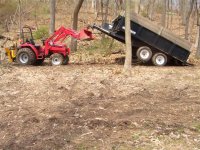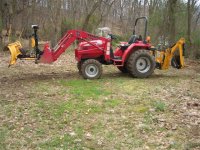Okay, one final time. Since I was not the genius who engineered the buckets, the hydraulic system, the axles, the loader arms, the loader mounting system etc. on the tractors, maybe I'm a fool for opting to believe the engineers at the Gainesville, GA Kubota plant who actually manufacturer loaders; one of which was on a Kubota tractor I owned. Several years ago my Kubota dealer called and actually spent quite a bit of time on the phone with a couple of engineers who explained to him exactly why any hooks welded or otherwise placed on a loader bucket should be placed in line with the loader arms or inside the loader arms. Since my warranty was at risk should I opt to believe the guy in the trailer down the street that has a 15 year old Jinma he got for $300 and mount the hooks as he did, I went with what the engineers and very large multi-line dealer told me. Apparently the engineers at CNH and JD are just as foolish as the ones employed by Kubota because they said the same thing.
So, you guys feel free to laugh all you want and give me all your reasons why I'm so foolish as to believe the manufacturers and the actual engineers who designed the loaders because that is exactly what I'm going to do. As I stated several times before, I really don't care where you mount your hooks on your tractor; it's your tractor. Mount them on your wheels for all I care. I just thought I'd post what is advised by the manufacturers and engineers who actually build the loaders for the remote reason someone would actually want to do what those guys advise. Obviously I missed on that one as well. I suppose to go along with the seasoned guys here, I'll just say "get 'er dun!" and leave it at that.



